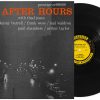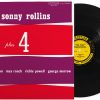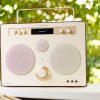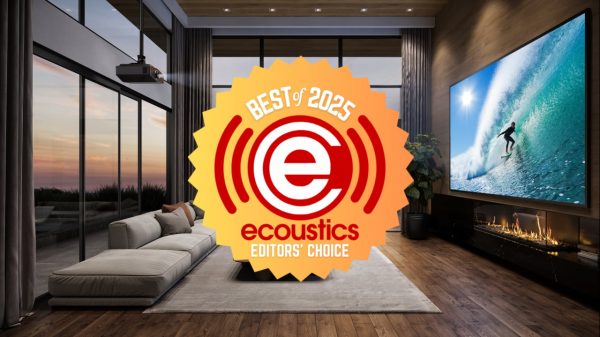At T.H.E. Show 2022, Common Wave Hi-Fi demonstrated an excellent system based around the DeVore Fidelity O/baby Loudspeakers. The O/baby use a horn-loaded .75″ textile dome tweeter and a new 7″ woofer using the same uncoated German paper as the O/96 and O/Reference.
DeVore Fidelity has worked with SEAS for the past decade on the drivers for the Orangutan Series and the O/baby continues that successful relationship. Steve Guttenberg has an excellent video interview with John filmed recently that fills in the gaps on these remarkable loudspeakers.
Having listened to the O/93 and O/96 loudspeakers multiple times over the years, I was rather excited to see what John DeVore could offer for $5,600 USD; the stands add $995 to the price of the system.


The integration of the 19mm textile dome tweeter is interesting; DeVore has it set inside the horn made from 20mm thick, six-layered marine plywood.
Unlike other DeVore designs, the O/baby have a sensitivity rating of 90dB (8 ohms) and seem like a very easy load.
The reality is that the specifications don’t tell the real story.
According to the dealer, they are more demanding of amplification and power definitely doesn’t dictate the end result.
Having owned two pairs of DeVore speakers over the years, I would concur with that statement.
Made in Brooklyn
The O/baby are not large loudspeakers (14.75″ W x 9.75″ D x 35″ H including optional stands) — and they definitely don’t sound like they appear.
Do they offer the scale of the O/93 or O/96? Not exactly.
They are definitely closer to the sound of the O/96 with sightly less transparency.

But what they do exceptionally well for such a small loudspeaker is deliver presence, texture, and the vibrancy of music — far more convincingly than other speakers in the category.
Listening to a number of indie rock vinyl recordings, I was immediately struck by the mid bass punch and organic feel of the presentation.
I would not use these in larger rooms; they will definitely perform better in small to medium sized rooms. They also don’t need to be pulled out as far from the walls as other DeVore designs.
When we switched over to jazz, the O/baby demonstrated that it’s a very intense and emotional listen; horns were pulled forward but with texture and excellent decay.
The bottom end is tight and quick but I wouldn’t expect the impact of the larger loudspeakers in the series.
A lot of high-end loudspeakers attempt to reproduce the scale of a piano; many of them fail miserably at it.
The O/baby succeeds despite its size and with incredible tonal weight and presence.

Listening to Monk, Art Tatum, McCoy Tyner, and Bud Powell — one can’t help but be amazed by how good these little loudspeakers are with jazz piano recordings.
The O/baby succeeds because DeVore has not tried to push the speaker beyond its limitations and create an O/96 for a lot less money; the more expensive loudspeaker delivers greater resolution, texture, color, and far more low end impact.
The width of the baffle does not restrict the size of the soundstage and there is a lively feel to the 0/baby that everyone present in the room found quiet beguiling. The O/baby doesn’t deliver the precise imaging of the DeVore Silverbacks but instruments have more body and presence.
Fast forward to late-2023 and another opportunity to listen and my initial impressions remain the same — although I do think they could benefit from two subwoofers if you have the space and budget.
I’m still on the fence about that.
The two aspects of the presentation that still stand out are the mid bass punch from such a small driver and cabinet, and the presence in the room.
Neutral they are not. And thank G-d for that.
Get the amplifier correct and these can hit one hard emotionally with some recordings.
Cosa mi consiglia?
One can use solid state or tubes with the O/baby and end up with very different — yet very satisfying results.
The bottom end needs some control. Do not sacrifice the mid bass punch of these speakers for a lot of extra clarity or detail.
Having listened to DeVore over the years with a variety of amplifiers from Shindo Labs, Leben, Pass Labs, Rega, Cambridge Audio, Moon By SimAudio, and NAD…I’m going to break the bank somewhat and recommend Unison Research.
I have long held the belief that audio components reflect the culture of the people behind them; the Italian obsession with design, craftsmanship, beauty, and quality is very evident here.

The Triode 25 Integrated Amplifier that I reviewed almost two years ago was a brilliant sounding amplifier, and an excellent option for loudspeakers that are somewhat reserved sounding; especially in the treble range.
The O/baby could work with the Triode 25, but my listening experience tells me that the Unison Research Simply 845 would be breathtaking with it.
Having owned 7 tube amplifiers over the past 30 years, my affection for them remains rather strong but is also tempered by the reality that they require a different level of maintenance and that one must always have some replacement tubes handy.
Supply chain issues have also made tubes more expensive and that is certainly true in regard to 300B and 845 output tubes.
The Unison Research Simply 845 caught my attention at CAF 2023 and it was a room that I returned to because it demonstrated an ability to handle both ends of the spectrum so well.

Delicate and quiet passages floated in the middle of the room and lingered just long enough for me to lean forward in my chair and absorb them.
Jazz trios with strong bass accompaniment felt rock solid and rich with texture; horns had wonderful bite and color and I walked out of the room to find Steve Jain and book some quality time with this amplifier.
The Simply 845 utilizes a pair of 845 tubes in a single-ended configuration that outputs 23 watts of Class A power.
The amplifier uses handmade in-house custom transformers, ECC82/12AU7s in the preamp stage and an ALPS RK27 motorized volume control; the unit is also self-biasing so all one needs to do is install the tubes and the unit takes care of the rest.
4 line level inputs and 2 sets of outputs (1 subwoofer, 1 tape) for those keeping score; one does need to add their own external phono stage for vinyl playback.
The 67 pounds of metal and wood are housed in a rather compact 14 1/2″ x 10 1/4″ x 22 1/2″ chassis.
The $9,995 USD price tag is very steep and that doesn’t mean that you have to spend that level of money to make the DeVore O/baby sing to the heavens — but this is one combination that will make you want to listen to music without pause for years.
Schnitzel With Peppers
Don’t knock it until you have tried it.
The goal was to keep the price of this system under $25,000 USD so there is going to be a greater degree of focus on analog playback. One can add almost any competent streamer from WiiM Audio, Bluesound, or Cambridge Audio for under $600 and be done with it.
The tonal balance of the DeVore/Unison system requires some careful system matching; going too dark can turn this system into a massive bore.

A Rega Planar 8 ($3,495) or Michell Gyro SE ($3,999) would be the right choice here with a more incisive sounding cartridge.
More than 20 years ago, a Michell Orbe SE was my daily driver and for almost 3 years, I enjoyed vinyl playback at a level that I had never known before.
The Michell Gyro SE is a lower-priced alternative to the Orbe SE and it many respects — is a much better deal for the money.
You can use other tonearms on the Gyro SE (SME was very popular at one point), but the Michell Technoarm 2 ($1,499) makes the most sense and it finishes off the exceptional industrial design in the right way.

There are few tables as beautiful as this one at any price; the package with the Technoarm 2 runs $5,500 USD and whilst that is not inexpensive by any stretch of the imagination, there is much more to this table than just conversation-inducing industrial design.
The Gyro SE might not deliver the Usain Bolt pacing of the Rega Naia or the thunderous control and resolution of the Kuzma Stabi R, but what it delivers for one third of the price is so musically engaging that one could not help but be enamored with it for life.
The build quality is extremely high and it requires so little maintenance to keep running at the highest level of playback. Michell has tinkered with this design for years and it feels like they have it exactly right.
It delivers the weight, resolution, clarity, rhythm, delicacy, and tone that can make listening to vinyl so emotionally rewarding.
Cartridge & Phono Pre-Amp?
All three of these will work well with the Michell; and it keeps with my theory in regard to spending more on the table than the cartridge. A better turntable will elevate the sound quality of a cartridge and not the other way around.
Not dropping thousands of dollars on a cartridge will also save money for the phono pre-amplifier and more records.

EAT E-Glo Petit
This $1,699 MM/MC phono stage which is manufactured by EAT (which is under the Pro-Ject umbrella) flies under the radar because of its branding and more limited distribution, but make no mistake — this is one of the best below $2,500 USD on the market and its flexibility and loading options are second to none.
Does it make sense to spend the additional $700 on the E-Glo Petit compared to the excellent Pro-Ject Tube Box DS2 which retails for $999 USD and offers similar gain settings and loading options?
I’ve owned the Pro-Ject for over 3 years and recommend it highly.
The biggest differences between the two would be the clarity, detail, resolution, and timbral accuracy of the more expensive unit.

Denon DL-103
Denon introduced the DL-103 in 1962 for professional broadcast use, and it has proven to be of the most popular and reliable phono cartridges of its kind. The low output moving coil design (0.3mV) requires a higher mass tonearm; opening the door to used Fidelity Research, SME, or EMT arms or more expensive modern arms from Kuzma, or Jelco (which recently decided to cease production). Jazz listeners have long prized the DL-103’s tonal balance and open presentation that make both brass instruments and vocals come alive.
The DL-103 requires at least 60dB of gain to come alive; sticking a step-up transformer between the affordable DL-103 and the moving magnet input of your phono stage can be a transformative experience when everything is set-up correctly. Third party manufacturers have been offering modified DL-103 variants for the past few years at considerable expense, but our advice would be to stick with the stock model from Denon.
Where to buy: $349 at Amazon

Sumiko Blue Point No. 3
The new Blue Point No. 3 cartridges were announced in June 2021, replacing the best-selling Blue Point No. 2, for an affordable ($499.00 each) MC design that produces great detail and stereo separation.
Both cartridges benefit from a new shell design, with a smoothly bevelled front fascia allowing excellent visibility of the stylus tip when mounting.
Pro-Ject offers the Blue Point No. 3 in both high output (2.5mV) and low output (0.5mV) versions.
The high output version is similar to my Dynavector 10×5 in that regard and whilst it has always worked rather well with my Croft Phono RIAA Phono Stage (42dB of gain) — it was clear that the Sumiko needed a few extra clicks on the volume control to reach the levels that I enjoy.
Where to buy: $499 at Amazon
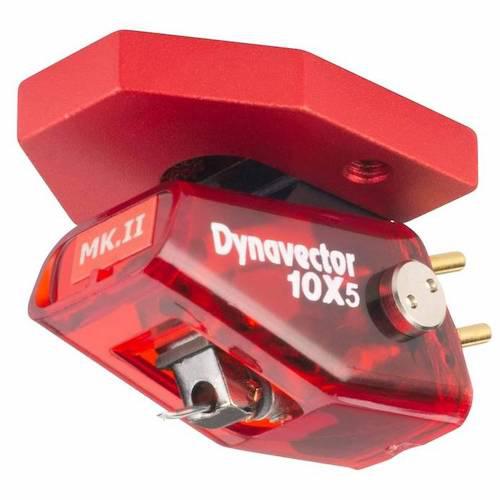
Dynavector 10×5 Mk2
Dynavector has offered this high output moving coil cartridge (2.5mV) for more than 20 years, and while not inexpensive, the 10×5 Mk2 may be the best overall cartridge of its kind with superb tracking, a balanced presentation, and excellent dynamics making it a great choice for jazz listeners. Installation used to be a tad cumbersome, but that issue has been resolved with some minor changes to the headshell.
The 10×5 Mk2 may not be the “best” at anything, but it has earned its reputation as a workhorse cartridge that manages to survive expensive table and tonearm upgrades. Vocals and brass have impressive presence, and there is a synergy between the 10×5 Mk2 and tube phono pre-amplifiers that makes it a final destination for many.
Where to buy: $800 at Audio Advice
Final Thoughts
$25,000 is a massive investment and my ultimate ceiling for this column which I started at Digital Trends in 2013.
Walking through CAF 2023, this would have been one of the least expensive systems at the show; which is a rather strong indictment of the industry that needs to focus more on systems below $10,000 to encourage a new generation of listeners to bite
Promoting systems that approach or exceed $100,000 as the “norm” will not have the results that manufacturers or retailers are hoping for.
If your budget for a system stretches to between $20,000 to $25,000 — this entire package should be high on your audition list. The level of engagement is beyond impressive for the asking price.
For more information: devorefidelity.com
Related Reading:






